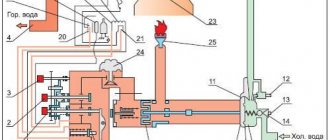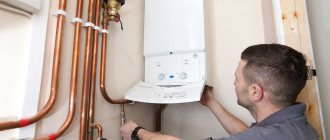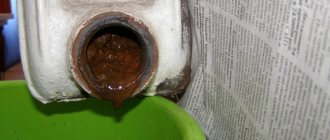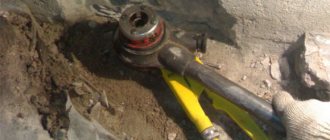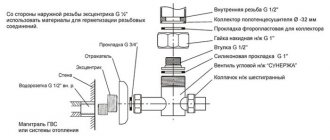Common problems
Let's look at what breakdowns occur in household gas instantaneous water heaters. These breakdowns are typical for water heaters Neva, Oasis, etc.
If the water heater does not ignite
Don't sound the alarm right away. Some of the problems are not very serious. With these malfunctions, the water heater can produce cotton when switched on.
Lack of traction
There is no draft in the exhaust duct. Maybe something got there that blocked the exhaust duct.
Or maybe there are a lot of combustion products in this channel - soot and it is clogged. The circuit breaker was triggered and the column stopped working. It is necessary to check the presence of traction. Bring a match to the ventilation, if there is a draft, the flame will be directed towards the channel. If there is no draft, then you need to call a chimney sweep and clean the channel.
You may not be able to do the cleaning of one of the channels. Part of the soot accumulates on the column itself, in order to remove it, you can vacuum the column.
In the absence of the necessary draft, the water heater can turn on, work a little and go out. Try opening the vent to increase the amount of air.
Old batteries
Another reason why the water heater does not turn on is that the battery life has expired, the batteries in the electronic device have simply run out. Change them and the problem will be fixed.
Weak water pressure
There may be insufficient cold water flow. This is easy to check by turning on the water tap. If the pressure of cold water is small, you need to call the management company and find out the reason.
Clogged shower
There may be such a reason: the pressure of hot water in the tap goes on, when you switch to the shower, it stops going. Check if the shower itself is clogged.
The water heater does not heat or does not heat the water well
This is most likely a water unit problem. There is a rubber membrane, which, for some reason, stops responding to the pressure of water, which, in turn, leads to the shutdown of the gas supply. There may be a crack in the membrane, salt deposits may accumulate due to hard water, or simply clogged.
The unit must be disassembled, the membrane must be cleaned or replaced, it is better to replace it with a silicone one. The coarse filter installed in the water unit may also be clogged.
Column blockage
The water may not heat well due to a blockage in the column itself. This is indicated by the soot that forms above it and the changed color of the gas.
Repairs
Low power
Perhaps your column has low power, so carefully read the characteristics of your unit.
Weak gas pressure
Water will not heat well at low gas pressure. In this case, call the gas service.
The water is very hot
This is not a breakdown of your unit. You just need to reduce the gas supply, turn the valve, which is located on the gas pipe in front of the column.
Gas smell
If you suddenly smell of gas, then you should not deal with this problem yourself. Call the gas service immediately. There should be no gas smell. Also, if when the column was turned on, the characteristic sound of gas turning on did not follow, that is, gas does not flow, you should contact specialists, gas workers.
Major breakdowns
There are several reasons why the gas water heater does not heat the water:
- Dirty heat exchanger. Regardless of the warranty, this happens with all heaters. Pipes from the inside are clogged with smoke and lime deposits, as a result, the gas column burns, but does not heat;
- Breakage of the gas valve in the burner. If this happens, the flame is not powerful enough to heat the water;
- Manufacturing defects. Most often, the problem is in the main element of the column - the heat exchanger. And this is one of the most common reasons why the gas column does not heat;
- Reduced pressure in the gas pipe. Malfunctions in the gas supply system and are not related to the operation of the device;
- The ignition has broken. It happens that the column does not turn on if the ignition breaks down or the battery runs out.
These are not the only options why the geyser does not heat water well. Each is worth considering separately.
Dirty chimney
One of the main reasons why the gas water heater does not heat water well is a clogged chimney. If the pipe is clogged with debris, there is not enough draft for normal operation of the device.

It is easy to eliminate this defect, it is enough to remove the chimney and clean it from the inside. If done correctly, thrust will appear.
How to check:
- Light a match;
- Bring it to the well;
- Look at the light.
The flame deviated - there is a draft, it burns evenly - you need to clean it more. If, after cleaning the chimney, the column still heats the water weakly, the reason must be sought elsewhere.
Defective ignition system
If the water heater does not ignite at all, there is a problem with ignition. This only happens with automatic devices that run on batteries. Despite the fact that according to advertisements, batteries work for a whole year, in fact, they run out much earlier.
To understand why the column does not heat up after replacing the battery, you need to carefully look at the contacts. If they become oxidized, they must be cleaned and tried to ignite the appliance again. Watch the ignition keys and check them periodically.
Weak pressure
Another reason why the gas water heater does not heat up is a false triggering of safety sensors. If the water pressure is too small, the system turns off the device.
Action options:
- Contact your utility company to determine the cause of the problem. It is possible that the problem is due to malfunctioning pipes;
- Clean filters;
- Clean the water heating elements from scale, soot and soot;
- Check the condition of the membrane.


It happens that with a low pressure, the device heats the water too much. This often happens with older models. Such columns do not have a protection system, they continue to burn even if there is no water. It will be safer to replace the device with a more modern one.
Repairs
If suddenly a leak appears in the flow-through water heater, then a fistula may have formed in the heat exchanger. If you want to make repairs yourself, then the water heater must be disassembled. Let's consider this process on the example of the "Neva" column.
We start the repair by turning off the water and gas supply by shutting off the taps.
Remove the cover. To do this, unscrew two screws at the bottom of the rear wall. Pulling the cover towards you, you need to drown two handles: one is a piezo igniter, the other is a gas adjustment. Then lift the cover up and remove.
So, the heat exchanger of the Neva gas column looks like:
Having found a fistula, you can solder it with a soldering iron. To do this, drain the water from the heat exchanger. Open the hot water tap and unscrew the nut from the cold water supply pipe. The water will drain, but not all. The rest must be blown out using some kind of hose, blow through the mouth so that the remaining water comes out. The pipes can then be soldered in the usual way. Perhaps the fistula ended up in the place where it is adjacent to the gas column. In this case, it is necessary to disassemble the entire column and remove the heat exchanger. Such a repair is much more difficult to do, since it will be necessary to disconnect the gas pipe. You can not solder the heat exchanger yourself, but replace it with a new one. Repair of the Neva water heater, see the video:
It is possible to leak at the point where the gas column pipe is connected to the water supply.In this case, it is necessary to change the gasket in the union nut.
Descaling
Insufficient heating of water can occur when scale forms inside instantaneous water heaters. This can be cleaned.
So, for example, the simplest Chinese-made Oasis instantaneous water heater can be cleaned without disassembling or removing it from the wall. Using a circulating pump, drive the water with acetic acid for about 40 minutes to dissolve the scale. Then rinse well with running water. Another problem is encountered during the operation of the Oasis: suddenly the column starts to warm up and turn off after a while. Be sure to clean the chimney. And before the arrival of a specialist, you cannot use the column. If the draft is good, then the Oasis column can be disassembled by yourself and the heat exchanger can be cleaned, there may be a reason in it, and you will not need additional repairs.
The designs of all modern instantaneous water heaters provide for an automatic shutdown of the gas supply when the water is turned off or the chimney is blocked. Therefore, there is no need to be afraid that a gas leak will occur.
The main and main purpose of gas water heaters is fast heating of cold water in an apartment or a private house. But this device, in spite of its relatively simple design, requires regular maintenance, otherwise it works worse and worse until the complete cessation of its functions. In a situation where the gas water heater does not heat the water, there are two ways out: first, you can seek advice and help from specialists, and the second is to try on your own to perform diagnostics and eliminate the malfunction. In the latter case, you need to know the principle of operation of a gas water heater and understand the types of breakdowns that could occur with the device.
The gas column does not heat the water due to a hole in the membrane:
When the gas column is turned on and off, the membrane of the water fittings is exposed to constant negative effects from the water pressure. This involuntarily forces it to constantly move inside the water unit and push through the internal mechanisms to open access to the gas. Such abrupt bending work wears out the rubber membrane, and it breaks. Longitudinal cracks and large holes that appear negatively affect the operation of the column, so if you notice that the gas water heater has begun to heat the water poorly, think about further maintenance with the replacement of consumables, rubber gaskets and a membrane.
The principle of operation and the reasons for the failure of the gas column
The principle of operation of any gas water heater, be it modern or old Soviet, is very simple. Gas is supplied inside the device, which in the process of combustion releases heat, heating the heat exchanger and the coil passing around it together with the flowing water. It turns out that cold water is brought into the column from the water supply, which heats up as it moves along the coil, and already hot water moves to the point of intake: a tap or a shower. In this case, the products of gas combustion are discharged into the chimney, and from there to the street.
There can be many reasons why the column does not heat the water. These include:
- long absence of device maintenance;
- a membrane that has lost its elasticity from prolonged use;
- clogged chimney;
- heat exchanger wear;
- malfunction of the ignition system;
- weak water pressure;
- problem in the water supply system;
- scale formation;
- low-power burner.
In order for the gas water heater to start heating the water again, it is necessary to diagnose the device, identify the malfunction and fix it on its own or with the help of a specialist.
The gas water heater does not heat the water for several reasons:
- Long-term lack of maintenance;
- Loss of elasticity and wear of the membrane;
- Accumulation of soot on the heat exchanger;
- Mixing cold water (mixer faulty);
- Incorrect operation of the valve (servo motor) of the gas control system;
- Heat exchanger wear by more than 20%.
- Weak burner power.
DIAGNOSTICS
On this page, we have detailed all the faults, so the cost of this service for you is
0 RUB
| CALL We will charge 500 rubles for the call in case of refusal to repair, and this service costs 0 RUB |
| SERVICE The cost of the performed technical work without the cost of the required spare parts in our company varies from 900 RUBLES |
| WARRANTY Before leaving, our employees will write out a guarantee from our company for the work done for a period of time. up to 6 MONTHS |
Diagnostics and troubleshooting
Diagnostics of a gas heater includes a thorough examination of it to detect possible causes that led to a decrease in the efficiency of the device, and their subsequent elimination.
The first reason why the water is barely warm or does not heat up at all is a blockage in the ventilation of the gas column.
Important! The chimney, clogged with smoke, soot or other debris, cannot provide the draft necessary for operation, therefore, the protective systems of the water heater stop the gas supply.
You can determine such a malfunction by substituting a lighted match to the ventilation hole. If the flame burns evenly, without hesitation, this means that there is no thrust. Falling black soot flakes also support this version. Another sign - the fire burns with a yellow flame
... This situation arises in the absence of regular cleaning of the column.
You can fix this malfunction with your own hands, for this you need clean the ventilation well
from soot, debris and other foreign objects. To check the chimney for draft after the work has been done, you can take a burning candle or lighter and bring it to the ventilation. If the flame deviates significantly, then there is a thrust.
Heat exchanger wear
With prolonged operation, the heat exchanger wears out, and may appear to leak
... This is typical for parts of poor quality, in which the element is not made of pure copper, but with impurities. In places of impurities, the surface is oxidized, and fistulas appear.
Advice! If the cracks or holes are small, you can try to solder them, but the best solution is to completely replace the heat exchanger.
Ignition system problem
If there is no flame in a Bosch or Neva column with automatic ignition, and the water does not heat up, it is necessary to check the condition of the batteries. They tend to discharge regularly and fail
and also sometimes oxidize. In some cases, you may get defective batteries. To check the ignition system, you need to change the batteries and, if the problem persists, diagnose the button that supplies the spark to ignite the gas.
Insufficient head
Sometimes the gas water heater may not perform its functions due to the fact that the protection system against starting without water is triggered
... This can happen with poor pressure in the pipes of the centralized water supply. To be sure of this reason, you need to open the tap with cold water and look at the stream. If it really does not flow well, then there are problems in the water supply system.
To remedy the situation, you must first call the utility service and find out if they are carrying out maintenance or repair work. If the answer is negative, then clean filters at the entrance to the gas water heater and / or to the water supply system in the house
from dirt and debris.
Advice! To clear the pipes from blockages in an apartment building, you must leave a request to the public service.
In addition to these actions, you need clean the gas water heater from soot and dust
, and also check the membrane for integrity and proper functioning, and, if necessary, install a new part.
Water supply disturbances
Such a breakdown is rare and indicates an incorrect setting of the water heater. If a the flame ignites, but immediately or after a short time goes out
, this indicates an imbalance in the hot and cold water supply system.
Advice! On many forums, you can read the opinion of experts that it is not recommended to mix cold water with hot water during the operation of the water heater, since this does not comply with the rules for operating the device, and also leads to the damping of the flame.
To eliminate such a malfunction, you need to reduce the flow of cold water.
Sealing diaphragm defective
If the diaphragm installed in the check valve has worked for a long time, it can cause a malfunction of the gas column. Due to regular loads and constant work, it is common for the node to deform. As a result, the burner ignition sensor becomes less sensitive, gas does not flow to the burner, and the flame goes out. It is impossible to prevent such a breakdown, even the highest quality membranes gradually lose their elasticity in the process of functioning. Column manufacturers, like service specialists, advise replacing this part every five to seven years
permanent work.
You can make sure that the cause of the breakdown lies precisely in the membrane by turning on the water flow to the maximum. If the gas burner goes out, the diagnosis can be considered confirmed. To fix the problem, you need replace part
.
The flame goes out
If the gas water heater ignites properly, but goes out during operation, this may indicate breakage of the bimetallic sensor
... It is designed to measure temperature in order to protect the water heater from overheating. Such a malfunction can manifest itself in different ways.
- In some cases, the device turns on, heats the water, but soon goes out, and it is impossible to start it up again. After about ten minutes, the column turns on again, works and goes out again after a short time. This is explained increased sensitivity of the bimetallic sensor
. - In other cases, the column lights up and after an arbitrary time goes out without visible dependence. It is impossible to guess how long it will work properly. This breakdown is usually caused by damaged wiring
... Due to broken insulation, short circuits to the case occur, and the fuse also trips.
Important! Failures in the operation of the bimetallic sensor cannot be eliminated independently. In this situation, you need to seek help from professionals.
In some cases, overheating of the device occurs in summer due to extreme heat
and stuffiness in the bathroom (or in another room). This is not a defect, but to prevent blackouts, the speaker can be moved to another room or you can seek professional advice.
Scale
Another reason why a Beretta, Junkers, Vektor or other manufacturer's column does not heat water or does not heat up, but very badly, is the scale on the heat exchanger. In this case, the gas enters the device in the required volume, the pressure is good, and the water moves in the system in the required amount, but it will not be able to warm up more than 34 degrees.
The appearance of scale is due to the contact of metal elements of equipment with hard water or the operation of the igniter. After the central system turns off, but the igniter fire is on, the heat exchanger evaporates the remaining moisture
, thereby increasing the amount of limescale. Since running water does not wash away such plaque, it accumulates and adheres tightly to the walls. When there is a lot of scale, the heat exchanger stops heating up, which means that the column stops heating water. To fix the breakdown, it is necessary to rinse the heating element in a special solution. To do this, you can contact a specialist or try to do it yourself.
Advice! To clean the heat exchanger from scale, you will need a special agent. You can use household chemicals that eliminate limescale, or you can use table vinegar or citric acid.
To disassemble the column, you need screwdrivers, a set of keys, silicone gaskets corresponding to the diameter of the pipe, as well as a tube and funnel for pouring the solution into the heat exchanger. So, for disassembling the water heater
you need to remove the regulators and other fittings, unscrew the fasteners and remove the case, then turn off the tap at the inlet to the device and open the hot water valve located near the column. Next, unscrew the nut, remove the incoming water pipe from the heat exchanger and drain the remaining water, the amount of which can be from a liter to one and a half.
After that, it is required to connect a rubber tube with a funnel to the coil, place it above the device and gradually pour up to two liters of descaling solution
... The amount depends on the capacity of the water heater. Then you need to keep the liquid inside for at least two and a half hours, better - longer. After the appointed time has elapsed, you need to connect the coil to the water supply, open the hot water tap and drain the waste liquid. Next, you need to flush the system and, if desired, repeat the cleaning procedure.
Advice! To prevent the formation of limescale, it is recommended to install a protective filter at the inlet of the column.
Breakage prevention
To avoid problems with the operation of the gas water heater, it is necessary to carry out its prevention at least once a year.
... For these procedures, it is recommended to call professionals, but if there is a desire to save money and perform these actions yourself, you need to disassemble the device, after shutting off the gas supply, and thoroughly clean it from the inside with a brush or rag. To improve the effect, you can use a vacuum cleaner.
Advice! In addition to the column, you need to inspect and clean the chimney, since if it is clogged, even a clean water heater will not work. In addition to removing soot and soot, it is necessary to periodically clean the heat exchanger from scale, especially if the igniter burns regularly throughout the day.
So, if the gas water heater does not heat water well or does not heat it at all, it is necessary to diagnose the device to identify the cause of the malfunction. This problem can be caused by many breakdowns of this type of water heater, many of which occur due to the lack of regular preventive maintenance of the device. After a malfunction is detected, you can try to fix it yourself or seek help from specialists if you are not confident in your own abilities.
Reasons for the lack of water heating
- Dirt deposits on the outside of the heat exchanger. A heat exchanger is a kind of metal tank in which water is heated. Since it is in contact with combustion products, a thick layer of soot can form on its outer walls, which prevents the water from heating to the desired temperature.
- Burner flame not strong enough. Sometimes the heating power is not enough for the water in the heat exchanger to reach the set temperature. If the flame in the burner is constantly low, this indicates a diaphragm malfunction, which leads to insufficient stem pressure on the gas valve.
- The heat exchanger is constantly overheating. This is most likely due to a manufacturing defect. In the absence of control over the temperature in the heat exchanger, a thick layer of scale settles on its walls, which prevents its normal operation.
- Low pressure level in gas pipes. This is a problem that has nothing to do with the operation of the water heater, since external factors are to blame. If you think that the pressure in the gas line is insufficient, contact the gas service.
- Neglect of prevention and maintenance.In the absence of proper care and timely repairs, malfunctions inevitably occur in the operation of gas equipment. If the gas water heater is in poor technical condition, it will not be able to provide a good pressure and the required water temperature.
Related article: Floor vases in the interior: all the subtleties of use (77 photos)
Best gas water heaters of 2020
Instantaneous water heater Zanussi GWH 10 Fonte Glass La Spezia on Yandex Market
Instantaneous water heater Mora Vega 10 on Yandex Market
Instantaneous water heater Zerten S-20 on Yandex Market
Instantaneous water heater Rinnai RW-14BF on Yandex Market
Instantaneous water heater BaltGaz Comfort 15 on Yandex Market
Wherever there is a water supply and centralized gas supply, the best way to obtain hot water is to heat it with a gas column. Today it is the most inexpensive method to provide DHW. In addition, the volume of hot water supply in this case is practically unlimited. Unfortunately, situations arise when hot water equipment starts to malfunction. How to determine the cause of the malfunction of the gas column, and what to do to restore the operability of the gas appliance, will be discussed below.
How is a flow-through gas water heater
In order to better understand the possible causes of failure, it is advisable to at least superficially know the structure of the equipment and the principle of its operation. Despite the fact that modern gas water heaters are very diverse both externally and in the design of individual units, they fundamentally differ little. All instantaneous water heaters have the following basic working units and designs:
- body;
- set of burners (main and igniter);
- tubular heat exchanger;
- automatic control unit;
- exhaust outlet;
- fittings for manual adjustment.
The start of the operation of the instantaneous water heater occurs according to the following scheme. When one of the hot water taps opens, the pressure in the pipeline changes, to which the corresponding sensor reacts. Then the signal goes to the automatic control system of the water heater. It allows gas to enter the central burner. The ignition of the energy carrier occurs from the igniter flame, which, in turn, ignites automatically in some models (electric ignition) or manually using a mechanical spark piezoelectric generator.
The automation of the gas water heater provides several protective functions. Therefore, the water heater will not start or stop working in situations:
- overheating of the heat exchanger;
- lack of sufficient traction;
- weak water pressure.
This must be taken into account if suddenly the column starts to malfunction for no apparent reason. In addition to the above, there are a number of factors that affect the quality of operation of an instantaneous water heater. Next, we will consider the main problems that may arise during the operation of the device, as well as the causes of breakdowns and how to eliminate them.
Scale in the heat exchanger
If the water used is hard, this problem can arise quite quickly after using a new column. Increases the rate of formation of salt deposits on the walls of the tubular heat exchanger and the high temperature of the heated water. Therefore, if these two factors take place, and at the same time the hot head in the tap becomes less and less (compared to the cold one), and the water warms up worse, it is worth suspecting a gradual increase in the thickness of the salt deposit on the inner surface of the heat exchanger tube. Further, a complete blockage of the section of the copper tube may occur.
It is possible to get rid of scale, but you have to work a little yourself or invite a specialist for this. If you are confident in your own abilities, you can try cleaning the heat exchanger yourself. As a reagent capable of dissolving the formed plaque, you can use:
- one of the factory's descaling products;
- table vinegar;
- food grade citric acid solution.
For work you will need:
- open-end wrenches and a set of screwdrivers;
- silicone or paronite gaskets (according to the diameter of the pipe section);
- rubber tube of appropriate diameter with funnel for filling the liquid.
To get to the heat exchanger coil and flush it, you need to follow these steps in sequence.
- Remove all handles and other hardware.
- Dismantle the housing.
- Cut off the water supply at the entrance.
- Open the hot water tap closest to the gas water heater.
- Remove the inlet water pipe from the heat exchanger, first unscrewing the nut on the connection, and drain the water (up to 1.5 liters).
- Connect a rubber tube to the coil inlet, raise its other end above the level of the gas appliance and gradually pour in the working fluid through the funnel (up to 2 liters, depending on the power of the device).
The liquid must be in the heat exchanger for at least 2.5 hours. If time permits, you can extend the procedure. Then you connect the coil to the water supply, resume the water supply and observe what will flow from the open hot tap (turbid whitish water with flakes impurities). After flushing, you can repeat the cleaning cycle to make sure.
Gas water heater cannot be started
If such problems have arisen, several reasons can be suspected that caused the breakdown, such as:
- the batteries in the igniter ignition system have sat down;
- the draft in the chimney has disappeared;
- weak water pressure.
In the first case, everything is simple - you need to replace the failed batteries, and everything will work.
The lack of traction can be checked with a lighted match, which must be brought to the column window. If the flame deviates towards the hole in the casing, everything is in order, there is a draft. If this does not happen, you need to think about the obstruction of the smoke exhaust ducts. This happens as a result of the chimney being clogged with soot or a foreign object gets there. In any case, it is necessary to restore the normal lumen of the smoke exhaust channel.
If the batteries are in order, and there are no problems with the draft, there is only an insufficient water pressure, which the automation does not perceive, in order to give the command to the working units of the water heating equipment to start working. It is easy to verify the existence of this particular reason. You just need to open the hot water tap and evaluate the intensity of the water jet. If the pressure is equally weak in a cold tap and in a hot tap, then there are problems outside the apartment or house. When, with a good cold head, the hot is noticeably weaker, you need to think that a pipe is clogged somewhere (less likely), or problems at the water inlet into the column.
In the second case, you need to disassemble the water block of the gas water heating device and clean the clogged mesh filter or replace the deformed membrane of the inlet valve.
The burner ignites, but then dies out soon after.
The main reason that can lead to such a breakdown is poorly contacting elements of the thermocouple and the solenoid valve that regulates the flow of gas to the main burner. In this case, you need to get to the named devices and clean the contacts.
Also, such a situation may arise when some elements of the automatic control unit of the geyser fail. If the automation is broken, it is better to invite a specialist to repair it.
The column does not heat water well
If such a problem exists initially, immediately after the start of operation of the new device, it means that the gas water heating device is selected with insufficient power. To avoid a situation when the gas water heater does not heat the water, consult with specialists before purchasing equipment.
If the column starts to heat up poorly during operation, it means that something is wrong with the burner.Although first you need to exclude the likelihood of scale formation inside the heat exchanger, as described above. If the burner becomes soiled, the color of the flame changes, soot appears, it is better not to touch the column yourself, but entrust the cleaning and restoration of its performance to the master.
On some models of gas water heaters, it is possible to adjust the volume of gas entering the burner. Perhaps the problem of insufficient heating of water can be solved by increasing the flow of energy.
In addition, the water will heat up weakly if there is a large pressure in the system and, accordingly, the speed of fluid passage through the heat exchanger coil. In this case, the water simply does not have time to warm up to the desired temperature. It is possible to correct the situation by closing the tap at the inlet to the column, thereby reducing the pressure.
There is a leak in the column
In the event of water leakage, two types of breakdown can be suspected:
- the gaskets in the existing connections have become unusable;
- corrosion has "eaten through" the fistula in the wall of the copper heat exchanger.
The first option is not very difficult to repair. You need to find the problematic connection and replace the gasket with a new one. Better to put a silicone seal, which is more reliable and lasts much longer. It makes sense to replace the gaskets not only in the place of leakage, but also in other joints, so that after a while you will not face the same problem, but in a different place.
The leaky section of the copper tube can be soldered so as not to change the entire expensive heat exchanger.
However, brazing copper is a specific occupation, therefore, there is no way without skills. So you need to invite a professional. In any case, it will come out much cheaper than purchasing a new coil.
Conclusion
Although gas water heaters are reliable and rarely break down, emergency situations happen with these products. If problems arise, you should first find out the cause of the breakdown, and only then proceed with the repair measures. And remember that if you are not confident in your own capabilities, it is better not to take independent action. Firstly, the product is not cheap, and secondly, you shouldn't joke with gas.
The main advantage of the gas water heater is the constant presence of hot water in the apartment or house. Their installation is especially relevant now, when there are constant problems with centralized water supply, and it is very costly to install electric water heaters. All this is good, but with columns, as with any equipment, sometimes problems occur, for example, the column does not heat the water. Why does this happen and what to do in this case?
Choosing a gas column
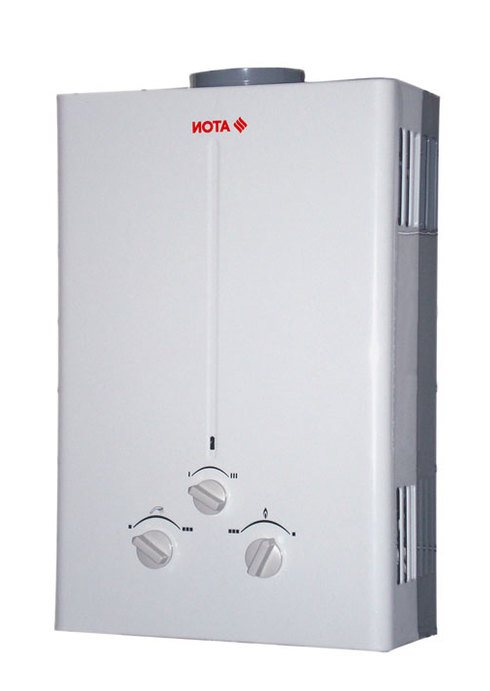

In order for the gas water heater to serve as long as possible, it is necessary to choose it correctly. Today, there is a technique on the market that does not need to be lit with matches as before, and which can heat water even with a minimum pressure. At the same time, it has a rather attractive appearance and compact dimensions. So, gas water heaters can be divided into three types. These are speakers with electric, manual and piezo ignition. Technique with manual ignition can be found very rarely today, except that it has remained from Soviet times. The geyser with piezo ignition can operate both on an accumulator and on batteries. To turn it on, you must press a button on the panel, as a result of which a spark appears, which ignites the fire. For subsequent operation, this does not need to be done, since the equipment will turn on independently with the inclusion of water in the tap.
Where to stay?


Electrically ignited speakers are perhaps the most reliable today. For their functioning, neither matches nor additional buttons are needed. The technique itself turns on when the water source is turned on and also turns itself off, which saves gas. Gas burners in columns can have both variable and constant power.If there is constant power, you need to independently regulate the temperature depending on the pressure, and if the power in technology is variable, the water temperature will change independently depending on the pressure.
Why does the gas water heater not heat the water?
There may be several reasons why the geyser does not heat or does not heat the water sufficiently. For example, this can cause poor performance. To solve this problem, you must carefully read the existing instructions. It may be necessary to replace the existing unit with a newer one. Also, the reason that the equipment does not heat can be its clogging. Signs of a blockage are an unusual yellow flame and soot underneath the unit.
In addition, the reason that the device does not heat the water can be low gas pressure. To fix this, you need to call a foreman from the gas section, who can check the malfunction using special devices. Also, if the gas column does not heat the liquid, it is necessary to check the draft in the chimney. It may be clogged and needs cleaning. Other reasons why the unit does not heat up may be a malfunction of the gas unit, combustion sensor or safety sensor. To eliminate them, you need to call the wizard.
If the water heater does not heat the water well, check if you are draining it before it heats up? Depending on the model of the boiler (its volume, power of the heating element), it will take 2-4 hours to heat the water. The input voltage of the electrical network also matters. If such "haste" is excluded, then you need to look for the causes of the breakdown.
Why is the gas water heater very hot
Overheating of the heat exchanger is mainly associated with the accumulation of scale inside the coil. At low pressure, the water will also quickly heat up to 50-60 ° C and above, and the rate of gas supply will be reduced to a minimum. The head in the supply line is stabilized using a boost pump.
Several signs indicate a clogged heat exchanger (scale build-up):
- the difference in pressure when opening a tap for hot and cold water supply;
- extraneous noise when heating water.
If, due to a clogged heat exchanger, the water becomes very hot, service must be carried out immediately. Boiling the liquid in the coil will cause an explosion.
The heat exchanger can be washed at home, with improvised means (citric acid and vinegar), or with special compounds to remove scale. Difficult blockages are removed in specialized workshops.
The main and main purpose of gas water heaters is fast heating of cold water in an apartment or a private house. But this device, in spite of its relatively simple design, requires regular maintenance, otherwise it works worse and worse until the complete cessation of its functions. In a situation where the gas water heater does not heat the water, there are two ways out: first, you can seek advice and help from specialists, and the second is to try on your own to perform diagnostics and eliminate the malfunction. In the latter case, you need to know the principle of operation of a gas water heater and understand the types of breakdowns that could occur with the device.
We check the performance of electrical elements
First, you should check the operation of the hot water valve, and then see if the indicator lamp for turning on the boiler is working.
If the light is off and the water heater stops heating the water, then the sequence of actions is as follows:
- The boiler is de-energized, freed from water, the housing cover is dismantled on it
- At the ends of the thermostat, you need to check for the presence of an incoming current. For this, it is advisable to use a special tester, not an indicator, in order to exclude a break in the supply "zero";
- If voltage is supplied, then you need to press the thermal protection button.Did this provide inclusion? Now, preventive cleaning of the heating element from scale will be required - it has overheated.
- Thermal protection could also be triggered due to the fact that hot water does not flow out of the tank due to a broken safety valve. Please note that the valve can only be replaced with a standard one - it is not recommended to install a conventional check valve here.
- You need to remove the thermostat and ring it. If it does not turn on, a replacement is needed. Repairing the thermostat is problematic - in most cases there are no mechanical elements in them.

